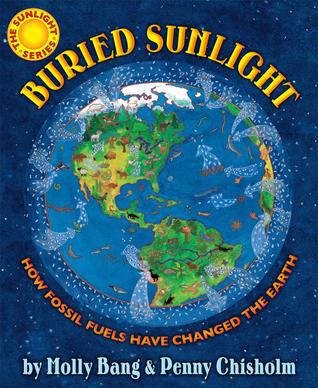 Have you ever wondered how to address climate change, or even just fossil fuels and energy, with young students? A complex and potentially heated topic, many people have argued that elementary school is too early to talk about these issues. Some teachers might even try to avoid the potential controversy by skipping over energy altogether, which is a lost opportunity for their students. A book by Molly Bang and Penny Chisholm, Buried Sunlight, could provide just the path you need to talk about these tricky topics with your young students.
Have you ever wondered how to address climate change, or even just fossil fuels and energy, with young students? A complex and potentially heated topic, many people have argued that elementary school is too early to talk about these issues. Some teachers might even try to avoid the potential controversy by skipping over energy altogether, which is a lost opportunity for their students. A book by Molly Bang and Penny Chisholm, Buried Sunlight, could provide just the path you need to talk about these tricky topics with your young students.
Narrated by an anthropomorphized Sun, calling itself “your golden star”, this illustrated children’s book follows the path of energy as it enters the Earth’s system, warms the “land, sea and…air” and ends up as fossil fuels, which is described as ancient life buried deep underground for millions of years. Through colorful illustrations, clear diagrams and clever descriptions, the Sun narrator takes us through the process of photosynthesis, (including phytoplankton—where most of the oxygen we breathe comes from), cellular respiration (talking about how we “breathe out the broken pieces of the chains as carbon dioxide”) and how fossil fuels were made (describing the process as plants and animals “pil[ing] up on the ocean floor” where they were then “squashed” to form fuels like coal, oil, and natural gas).
If this were the entire book, that would certainly be enough—but wisely the authors address the final piece of this story by discussing climate change. The last few pages discuss how humans use fossil fuels, releasing carbon dioxide into the atmosphere. In her discussion of climate change, the authors introduce key concepts like the greenhouse effect as well as the effects of global warming on Arctic ice and glaciers, warming seas that are beginning to creep onto land, and fiercer storms, drought, and floods. The authors even takes the time to say that even though the Earth’s climate has changed many times from over millions of years, these changes occurred very slowly, allowing living things to adapt to the changing climates. Since today's changes are occurring very quickly, the book asks the questions “how many living creatures will be able to adjust?” and “how will it change the way humans live?” Those are questions for students to think about, and are worthy of discussion.
Although the book is geared towards students in third through sixth grades, there is quite a bit of useful information for older students. For example, I teach high school biology and could see using this book when introducing global warming to my students, due to its clear illustrations and adherence to the science. Global warming, fossil fuels, and energy usage are some of the most important concepts of our times. What students learn at a young age has the potential to influence them for the rest of their lives. This book isn’t an answer to all of the problems regarding energy education, but it’s a start. It's a great way to get students thinking about their energy usage. The first step though, can be through a simple illustrated book on buried sunlight.
Interested in other books by Molly Bang and Penny Chisholm? NCSE has two books to give away: Ocean Sunlight: How Tiny Plants Feed the Seas and Living Sunlight: How Plants Bring The Earth To Life. Enter to win a copy here!
Barbara A. O’Malia is a high school science teacher in Elyria, Ohio. She teaches anatomy & physiology, and biology. She is also a registered medical technologist and worked in the clinical laboratory for many years before becoming a high school science teacher. Her areas of expertise are hematology and microbiology. She lives in Fairview Park, OH, with her husband, Brian, son, Sean, and golden retriever, Ginger.
